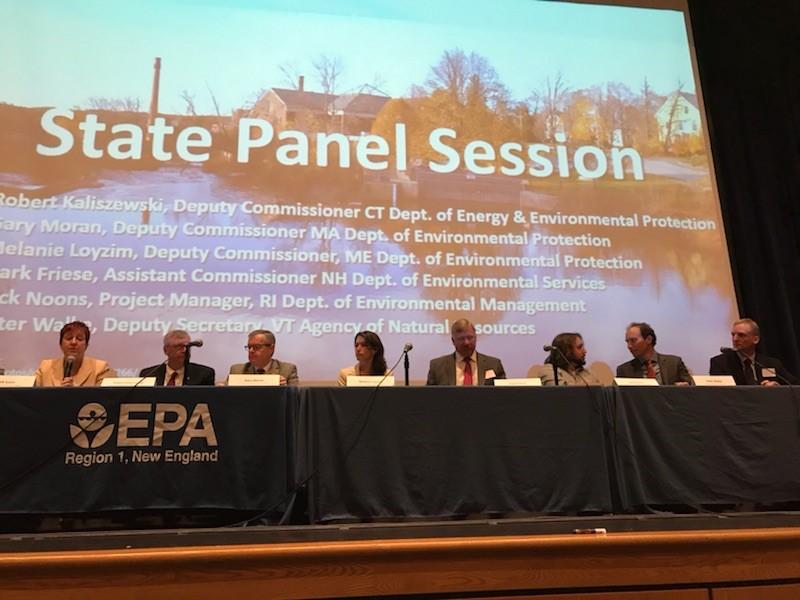News Releases from Headquarters›Water (OW)
EPA Concludes Historic PFAS Community Engagement Event in New Hampshire
Two-Day Event Filled with Productive Listening and Working Sessions with Communities and State Partners
Exeter, N.H. – Today, the U.S. Environmental Protection Agency (EPA) wrapped up the second day of the first ever per- and polyfluoroalkyl substances (PFAS) Community Engagement event in Exeter, N.H. Today’s session brought together key stakeholders and state partners to discuss and gather input to help inform EPA’s plan for managing PFAS, which is set to be released by the end of the year.
“EPA is taking concrete steps to address PFAS and the input we heard over the past two days will help us develop a plan for managing PFAS,” said EPA New England Regional Administrator Alexandra Dunn. “Today’s community engagement event was critical for hearing directly from communities who are on the ground dealing with these issues.”
With nearly 200 people in attendance, there were a series of EPA, state, and local speakers giving updates on EPA New England regional efforts; individual state efforts; and local community efforts on PFAS found in the environment in New England.
EPA Administrator Scott Pruitt announced these four actions at the PFAS National Leadership Summit:
-
EPA will initiate steps to evaluate the need for a maximum contaminant level (MCL) for PFOA and PFOS. We will convene our federal partners and examine everything we know about PFOA and PFOS in drinking water.
-
EPA is beginning the necessary steps to propose designating PFOA and PFOS as “hazardous substances” through one of the available statutory mechanisms, including potentially CERCLA Section 102.
-
EPA is currently developing groundwater cleanup recommendations for PFOA and PFOS at contaminated sites and will complete this task by fall of this year.
-
EPA is taking action in close collaboration with our federal and state partners to develop toxicity values for GenX and PFBS by this summer.
What New England states are saying:
“Coordination between state and federal agencies is vital as we address today’s most pressing environmental challenges, including climate change mitigation and adaptation, ozone transport, and emerging contaminants. The Connecticut Department of Energy and Environmental Protection is committed to working closely with EPA Region 1 and our state colleagues in New England and across the country to ensure that we are protecting the health and safety of all of our residents. We appreciate the highly collaborative relationship Connecticut has always had with EPA Region 1,” said Connecticut Department of Energy and Environmental Protection Commissioner Rob Klee.
“Maine supports the efforts of EPA to gather information from all stakeholders and to develop a national, consistent approach to PFAS contamination,” said Maine Department of Environmental Protection Deputy Commissioner Melanie Loyzim.
"Massachusetts is pleased to see national and regional attention focused on PFAS contaminants," said Massachusetts Department of Environmental Protection (MassDEP) Deputy Commissioner Gary Moran. "MassDEP recently issued a protective health advisory for PFAS compounds based on the latest science, and we continue to work with communities to address this issue."
“We are pleased that EPA was able to hear from our local communities about their concerns regarding PFAS contamination in drinking water and our environment. We look forward to working with EPA to promptly establish PFAS drinking water standards,” said New Hampshire Department of Environmental Services Commissioner Bob Scott.
"Emerging contaminants, including the poly- and perfluoroalkyl substances or PFAs, are a serious concern in Rhode Island and throughout New England," said Rhode Island Department of Environmental Management Director Janet Coit. "Communicating the complexity of the science and the risks posed by these chemicals is both difficult and critically important. It is great to see EPA Region I organizing this first-in-the-country regional dialog with community groups and states on this issue. The experiences, perspectives, and lessons learned shared at this workshop will be invaluable to improving our response to these challenges going forward."
“Vermont would like to thank the EPA for bringing the federal government, state governments, and community groups together to work collaboratively to address the existing and future challenges associated with PFAS contamination,” said Vermont Agency of Natural Resources Deputy Secretary Peter Walke. “Vermont looks forward to continuing to lead with our partners to address PFAS in Vermont. We call on the EPA to use all of the tools in the federal toolbox to address existing contamination and to prevent further contamination.
In the afternoon, EPA hosted panel discussions on specific areas. The sessions, similar to those at the historic PFAS National Leadership Summit last month focused on (1) Identifying PFAS; (2) Communicating PFAS; and (3) Identifying Solutions for PFAS.
Overall, the two-day community engagement event encouraged New England community members to voice concerns and feedback to EPA. Public engagement of this nature is incredibly valuable to the development of EPA’s PFAS management plan and understanding of PFAS chemicals in New England.
Background
PFAS is a group of man-made chemicals that have been widely used in everyday products since the 1940s. But PFAS compounds also can enter the environment, raising concerns about the potential environmental and health risks. PFAS have been detected in groundwater in some New England communities.
Citizens are also encouraged to submit written statements to the public docket at https://www.regulations.gov/ enter docket number: OW-2018-0270. A summary of the New England community engagement event will be made available on the PFAS Community Engagement website following the event.
New Hampshire marks the first community engagement. Throughout the summer, EPA will visit and similarly engage with additional communities across the country. Information on these upcoming sessions will also be available on the EPA website.
Additional information can be found at: https://www.epa.gov/pfas/pfas-community-engagement

